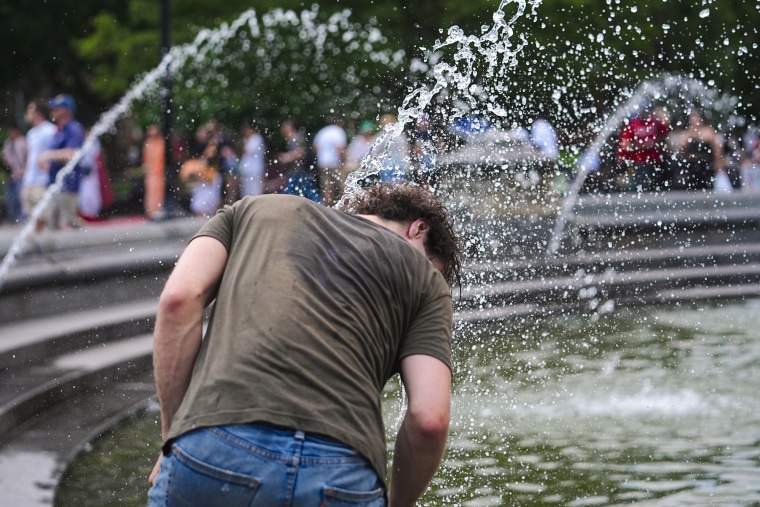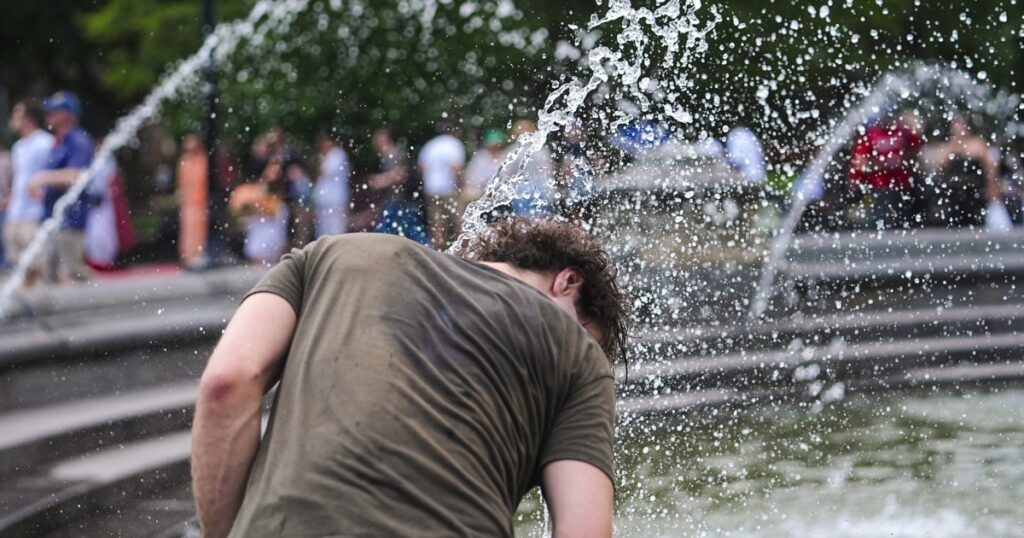An extremely dangerous heat wave is predicted to hit the Midwest and the East Coast on Monday and Tuesday, with the National Weather Service warning that triple-digit heat is expected.
The most significant impacts are anticipated in the mid-Atlantic and the Ohio Valley, with densely populated areas such as Pittsburgh and Washington, D.C., among the most vulnerable locations, according to the Weather Prediction Center.
Heat was the deadliest type of weather event last year, and staying safe in extreme temperatures is essential. Finding cooling centers, staying hydrated and being aware of the symptoms of heat-related illnesses can help people safely navigate the first record-setting heat wave of the summer.

First, find air conditioning
For navigating the extreme heat indoors, the top priority should be finding an air-conditioned space, said Dr. Natalie Araz, an NBC News medical contributor.
Central air and window units do not have to be on the coldest settings to be effective, Araz said — setting an air conditioner at 78 degrees while running a fan can still provide relief. To conserve energy and cut costs, window units have to be run only in rooms where people are, not throughout the entire household.
But for those living in spaces not equipped with air conditioning, finding a cool location is essential.
“In the heat like this, indoors, you need to be getting to a cooling center,” Araz said. “There’s kind of like no ifs, ands or buts on that.”
The National Center for Healthy Housing has a list of each state’s resources for finding cooling centers.
Many cities offer cooling centers open to the public, such as the New York Public Library branches in Manhattan. Visitors can stay as long as they need during the library’s business hours and do not need library cards to enter, a spokesperson for the library said.
Other major metropolitan cities bracing for this week’s heat, like Chicago and Philadelphia, have public lists of cooling locations, as do many smaller city websites.
Besides a community cooling center, spending time in a mall or a movie theater can be a simple way to stay protected. Another option is finding a local pool or a splash pad, especially for young children.
Carissa Gutierrez was bracing for the coming days of extreme heat Saturday in Chicago at the public pool across the street from where she lives in a basement apartment with no air conditioning.
“To say I’m ready, probably not,” Gutierrez said. “But we have lots of fans.”
Allison Beaulieu-Cholke was also at the pool with her daughter, Viola, after having handed out waters and ice cream sandwiches at a church to help keep others cool in heat that she said is concerning.
“A lot of people don’t have anywhere to be right now,” she said.
Staying safe in a heat wave
Whether you are indoors or outside, staying hydrated is key in a heat wave. Araz said to drink water throughout the day, even when you are not yet feeling thirsty, and to avoid caffeinated and alcoholic beverages. Avoid heavy meals and try to eat fruits with high water content, such as watermelon or cantaloupe.
Araz also advised people to be aware of medications that can lead to dehydration, such as diuretics or antihistamines.
During the hottest times of the day, about 11 a.m. to 4 p.m., try to stay indoors in air conditioning and save any outdoor exercise for the early mornings or the late evenings. Wear light-colored, loose-fitting clothing.
Medical professionals often remind people to check on family members and friends, especially older folks or those who may have difficulty with communicating how they are feeling, Araz said. Young children and infants, people with chronic medical conditions and pregnant women are other populations vulnerable to heat affects.
“Never, ever leave a person, a child, a dog in a car during these temperatures, not even for a couple of minutes,” Araz said.
Symptoms to watch for
One of the first symptoms of heat-related illnesses is heat cramps accompanied by heavy sweating, Araz said. If people begin to experience such symptoms, they should be moved to a cooler location and given small sips of water — up to a half-glass every 15 minutes.
Heat exhaustion is the next tier of illness, in which people may experience either a weak or a rapid pulse, fainting and nausea. If someone is experiencing this more severe condition, remove as much clothing from the person as possible, Araz said, and apply cool, wet cloths underneath the arms. If someone begins vomiting, do not give any fluids.
If symptoms do not improve and they escalate to heatstroke, the body will begin to stop sweating, with dry, red skin and a rapid pulse or breathing. That requires immediate medical attention, Araz said.
“If you’re even at all suspicious about heatstroke, you have to call 911 right away,” Araz said. “It’s a medical emergency.”

